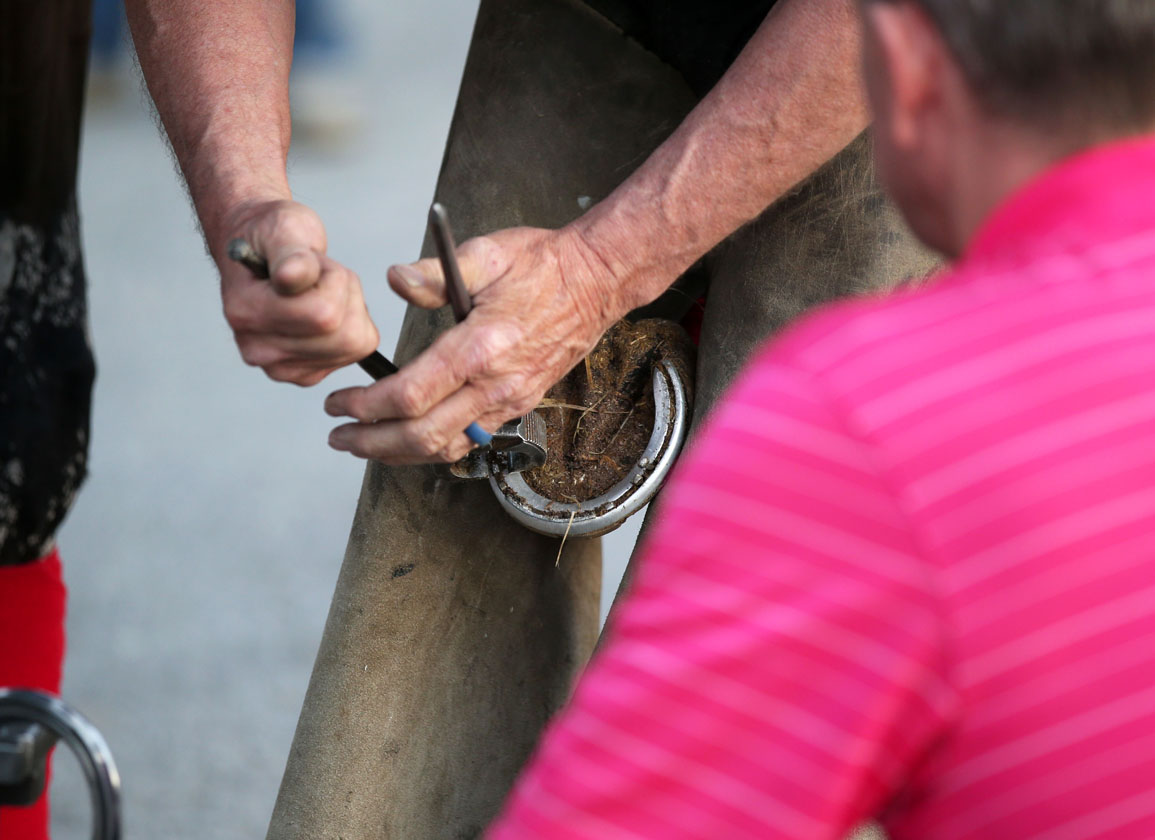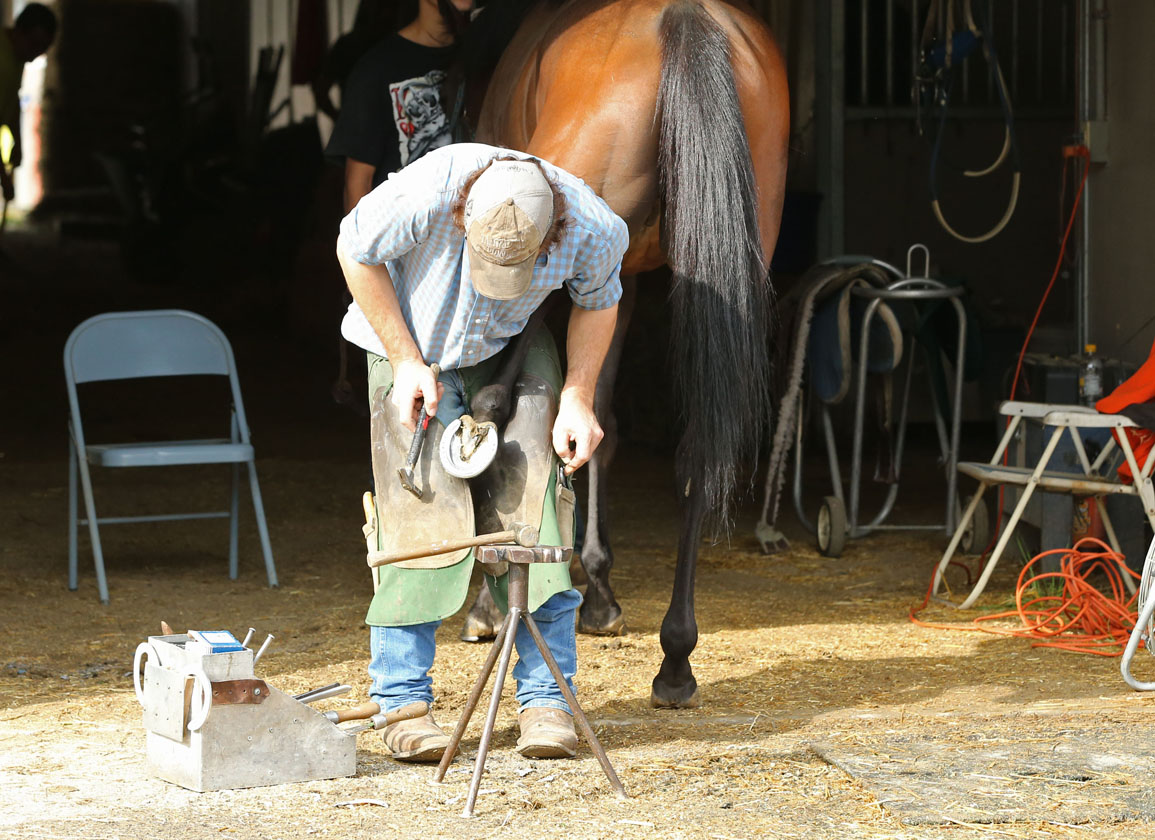By Jude R. Florio
Farrier Tales continues to pull back the curtain on all things horse, horseshoeing, farrier, and related science, attempting to provide useful information and insight for horse professionals and enthusiasts.
Have you ever wondered why your farrier often seems so grumpy? The headline, a quote from the classic movie Cool Hand Luke, basically sums it up.
Over the course of my career, I have cultivated innumerable friendships with a number of colleagues from various backgrounds and nationalities. Despite our broad range of disciplines and skill sets, many of our shared concerns and frustrations appear consistent.
Of course, a farrier's demeanor can likely be attributable to the demanding nature and labor intensiveness of the trade, however, most farriers, myself included, actually enjoy the craft, accepting the inherent risks while enduring the physical stress. I suspect like me, many farriers–like most industry professionals–have been bit by the horse bug early on. Farriers revel in the success of the client's horses, knowing the important role played, and by extension, no farrier enjoys failure, paining most terribly upon news that a horse may be “off” as a result of something connected to a service performed.
Truth be told, my perceived grumpiness predates my years as a farrier. It has always been my “schtick,” and many clients find it very entertaining. However, there are a number of things that can occur which may put your farrier's “Bad Mood Jude” into overdrive.
I have highlighted the most likely (and frequent) scenarios, excluding physical health issues and/or matters of a personal nature (family, children) that may affect one's demeanor and overall performance.
You Owe the Farrier Money
Nonpayment for services rendered is an obvious one but is all too common and, unfortunately, something farriers experience. A universally shared disappointment amongst farriers, nonpayment underscores the apparent disconnect within the horse industry. Trainers, owners, and farriers should establish terms of payment in advance of any service rendered and, as with anything, communication is key. Guaranteeing and maintaining verbal commitments (on both sides) is paramount, as well as openly discussing potential payment issue(s) in advance of future visits. I suspect any good farrier who conducts themselves professionally, shows up on time, and performs excellent work will be much happier when leaving at the day's close with check in hand.
Behavioral Issues Which Make it Difficult to Shoe
All farriers are expected to understand and accept the inherent risks that may come as a result of handling and shoeing horses. A horse's behavior is a key component to a farrier's ability to properly and safely carry out their job. Arguably shoeing is likely the most invasive thing which is routinely performed on horses where an error can be career ending or worse. The saying “no hoof, no horse” underscores why owners and trainers with expectations of a good job should not only include steps to ensure the horse's appropriate behavior for shoeing, but also include a concern for your farrier's well-being. Considerate and mindful owners who properly manage horses with behavioral issues will likely be rewarded with reductions in farrier “crankiness” and gain greater appreciation for the assistance provided.
Training Your Horse for the Farrier
It is important to always disclose any and all pre-existing known issues to your farrier beforehand, since this can prove vital to your horse's and farrier's safety. I have personally experienced countless occasions where critical information and shoeing-related poor behavior have gone undisclosed. Needless to say, these types of instances do not bring smiles to any farrier's face.
Most farriers are willing to work with a difficult horse, including offering up some advice and recommendations attempting to address the issue(s). If you are a valued customer, most farriers will happily attempt to work through solvable problems. Excluding a rogue, where no amount of training will work, and others with old injuries, unbreakable quirks, or traumatic events which result in a protective response, many horses will come around within two or three shoeings with some work. I have the good fortune to work on a lot of nice horses who stand like statues, so I know it is possible.
Also, having had a lot of past experience working with young horses (foals, weanlings, yearlings, etc.), the stall is a great tool that should be used to address farrier behavioral issues and to attempt to work through them. The stall limits space, including distractions and use of the wall and/or corners requires the horse to focus on handler instructions.
Proper training for the farrier is usually a two-person job: handlers/holders should always be active and not passive. Nothing makes me crabbier than a handler who is texting away, watching a video, or sitting down, while I'm getting my teeth knocked in at the other end of Buttercup. I appreciate that handling horses for the farrier is usually boring and uneventful, however, it is an essential job for everyone's safety which includes the horse and it is greatly appreciated.
Discuss a Farrier's List in Advance
Most farriers tend to have a strategy in mind as it relates to tackling a group or list of horses. I am somewhat robotic in my practice and depending on the particular horse and what is required I am like clockwork. Additionally, I know how much fuel I have in my tank and I suspect other farriers are similar. Discussing in advance a group of horses due and seeking your farrier's input on how they may want to address a group will go a long way in irritable farrier alleviation.
My preference has always been to do difficult horses last, recognizing extra time and energy may be required. Doing a difficult horse first may deplete energy required for the rest of the list, potentially short-changing work quality. Sensitive horses recognize and react to frustration; a farrier that is slowed down or jerked around at the start unfortunately sets the wrong tone for the rest of the day.
Most farriers recognize that there are multiple factors which may go into devising a shoeing list, however, seeking their input would be refreshing.
Consider Sedation When Necessary and Possible
Many years ago, I had a client with a 17.3-hand, mixed-breed mare. The mare was occasionally very uncooperative for shoeing and eventually dangerous. I can not say if it was behavioral, pain-related or, most likely, a combination of both. She was certainly aware of her size and strength, using it to her advantage. Handling and shoeing had become a pointless spectacle, at times dangerous for all parties involved. I had strongly recommended that the owner consider sedation for shoeing. To my surprise and dismay, the owner said, “I'd put the horse down before I would sedate for shoeing!” Since these types of sentiments get farriers, horses, and people injured or worse, I knew it was my time to move on.
To underscore the point, I believe sedation, when necessary and used appropriately, is a very useful tool and not unlike other training aids. Sedation/tranquilizers exist in many forms and their use “takes the edge off.” This includes the new types of oral gel tranquilizer, which I have occasionally used (when necessary) with great success. The oral gel takes slightly longer to take effect but as with most types of sedation, the horse has an awareness and a better experience, learning acceptance and coping with the process. In many cases sedation can be reduced and in some instances discontinued.
Common Sense Courtesies
After having considered all of the aforementioned issues, a few other additional factors bear taking note. It is important to provide a somewhat clean, level, well-lit (natural light being the optimum), quiet area devoid of constant traffic (pedestrian, horse or otherwise). When possible, schedule farrier visits when the facility tends to be quiet (for example: landscapers, construction, heavy equipment, and machinery operating near or around the stabling area tend to unsettle and distract horses). The bottom line is that quality work comes from communication, cooperation, and safety which focuses both on human and horse alike.
All grumbles aside, most farriers are reasonable, hard-working individuals singularly motivated to provide the best service possible, keeping horses comfortable, sound, and happy. Reasonable attempts at making a farrier's life “easier” will keep them smiling.
Not a subscriber? Click here to sign up for the daily PDF or alerts.








